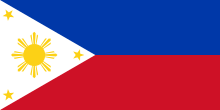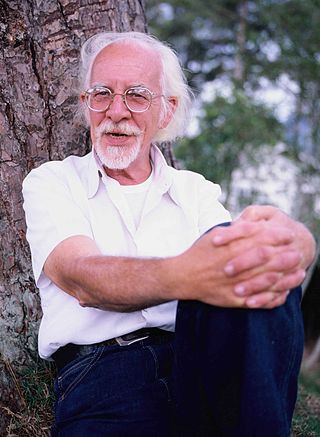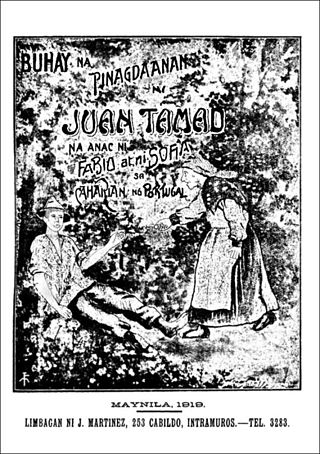

This is a bibliography of works on the Philippines.


This is a bibliography of works on the Philippines.

The Philippines, officially the Republic of the Philippines, is an archipelagic country in Southeast Asia. In the western Pacific Ocean, it consists of 7,641 islands, with a total area of roughly 300,000 square kilometers, which are broadly categorized in three main geographical divisions from north to south: Luzon, Visayas, and Mindanao. The Philippines is bounded by the South China Sea to the west, the Philippine Sea to the east, and the Celebes Sea to the south. It shares maritime borders with Taiwan to the north, Japan to the northeast, Palau to the east and southeast, Indonesia to the south, Malaysia to the southwest, Vietnam to the west, and China to the northwest. It is the world's twelfth-most-populous country, with diverse ethnicities and cultures. Manila is the country's capital, and its most populated city is Quezon City. Both are within Metro Manila.

The history of the Philippines dates from the earliest hominin activity in the archipelago at least by 709,000 years ago. Homo luzonensis, a species of archaic humans, was present on the island of Luzon at least by 134,000 years ago.
Politics in the Philippines are governed by a three-branch system of government. The country is a democracy, with a president who is directly elected by the people and serves as both the head of state and the head of government. The president serves as the leader of the executive branch and is a powerful political figure. A president may only hold office for one six-year term. The bicameral Congress consists of two separate bodies: the Senate, with members elected at-large across the country, and the larger House of Representatives, with members chosen mostly from specific geographic districts. The Congress performs legislative functions. The judiciary is overseen by the Supreme Court of the Philippines and has extensive review jurisdiction over judgments issued by other governmental and administrative institutions.

Islam in the Philippines is the second largest religion in the country, and the faith was the first-recorded monotheistic religion in the Philippines. Historically, Islam reached the Philippine archipelago in the 14th century, through contact with Muslim Malay and Arab merchants along Southeast Asian trade networks, in addition to Yemeni missionaries from the tribe of Alawi of Yemen from the Persian Gulf, southern India, and their followers from several sultanates in the wider Malay Archipelago. The first missionaries then followed in the late 14th and early 15th centuries. They facilitated the formation of sultanates and conquests in mainland Mindanao and Sulu. Those who converted to Islam came to be known as the Moros, with Muslim conquest reaching as far as Tondo that was later supplanted by Bruneian Empire vassal-state of Maynila.

The history of the Philippines from 1898 to 1946 is known as the American colonial period, and began with the outbreak of the Spanish–American War in April 1898, when the Philippines was still a colony of the Spanish East Indies, and concluded when the United States formally recognized the independence of the Republic of the Philippines on July 4, 1946.

William Henry Scott was a historian of the Cordillera Central and pre-Hispanic Philippines.
Felipe Landa Jocano was a Filipino anthropologist, educator, and author known for his significant body of work within the field of Philippine Anthropology, and in particular for documenting and translating the Hinilawod, a Western Visayan folk epic. His eminence within the field of Philippine anthropology was widely recognized during his lifetime, with National Artist F. Sionil Jose dubbing him "the country's first and foremost cultural anthropologist"

Philippine folk literature refers to the traditional oral literature of the Filipino people. Thus, the scope of the field covers the ancient folk literature of the Philippines' various ethnic groups, as well as various pieces of folklore that have evolved since the Philippines became a single ethno-political unit.

The recorded history of the Philippines between 900 and 1565 begins with the creation of the Laguna Copperplate Inscription in 900 and ends with the beginning of Spanish colonization in 1565. The inscription records its date of creation in 822 Saka. The discovery of this document marks the end of the prehistory of the Philippines at 900 AD. During this historical time period, the Philippine archipelago was home to numerous kingdoms and sultanates and was a part of the Indosphere and Sinosphere.

Since H. Otley Beyer first proposed his wave migration theory, numerous scholars have approached the question of how, when and why humans first came to the Philippines. The current scientific consensus favors the "Out of Taiwan" model, which broadly match linguistic, genetic, archaeological, and cultural evidence.

The history of the Philippines from 1565 to 1898 is known as the Spanish colonial period, during which the Philippine Islands were ruled as the Captaincy General of the Philippines within the Spanish East Indies, initially under the Viceroyalty of New Spain, based in Mexico City, until the independence of the Mexican Empire from Spain in 1821. This resulted in direct Spanish control during a period of governmental instability there.
Elections for the House of Representatives of the Philippines were held on November 14, 1961. Held on the same day as the presidential election, the party of the incumbent president, Carlos P. Garcia's Nacionalista Party, won majority of the seats in the House of Representatives. However, Diosdado Macapagal of the opposition Liberal Party won the presidential election, leading to majority of the elected Nacionalista congressmen to defect to the Liberal Party. This led to Cornelio Villareal being elected Speaker of the House of Representatives.
The Partido Obrero de Filipinas was a Marxist political party formed in 1924 by Filipino labor organizers Crisanto Evangelista, Domingo Ponce and Cirilo Bognot during the administration of the Insular Government of the Philippine Islands. This party later formed the core of the Partido Komunista ng Pilipinas which was established in 1930.

The Katipunan ng mga Anak-Pawis sa Pilipinas (KAP) was the third trade union federation in the Philippines. It was formed in 1929 after an antagonistic national convention of the Congreso Obrero de Filipinas where election results were manipulated, causing Crisanto Evangelista and his faction to split from the COF. In 1930, the KAP changed its name to Partido Komunista ng Pilipinas after it initiated the formation of a "mass political party" and questions arose regarding its name.
Anarchism in the Philippines has its roots in the anti-colonial struggle against the Spanish Empire, becoming influential in the Philippine Revolution and the country's early trade unionist movement. After being supplanted by Marxism-Leninism as the leading revolutionary tendency during the mid-20th century, it experienced a resurgence as part of the punk subculture, following the fragmentation of the Communist Party of the Philippines.

Early polities in what is now the Philippines were small entities known as barangays, although some larger states were established following the arrival of Hinduism and Islam through regional trade networks. The arrival of Spanish settlers began a period of Spanish expansion which led to the creation of the Captaincy General of the Philippines, governed out of Manila. While technically part of New Spain, the Philippines functioned mostly autonomously. The reliance on native leaders to help govern led to the creation of an elite class known as the principalia. Spanish control was never firmly established over much of its claimed territory, with some inland and Islamic regions remaining effectively independent.
Polo y servicio was the forced labor system without compensation imposed upon the local population in the Philippines during the Spanish colonial period. In concept, it was similar to Repartimiento, a forced labor system used in the Spanish America.